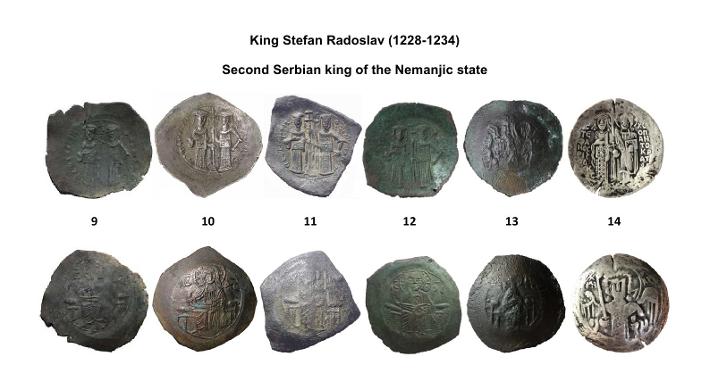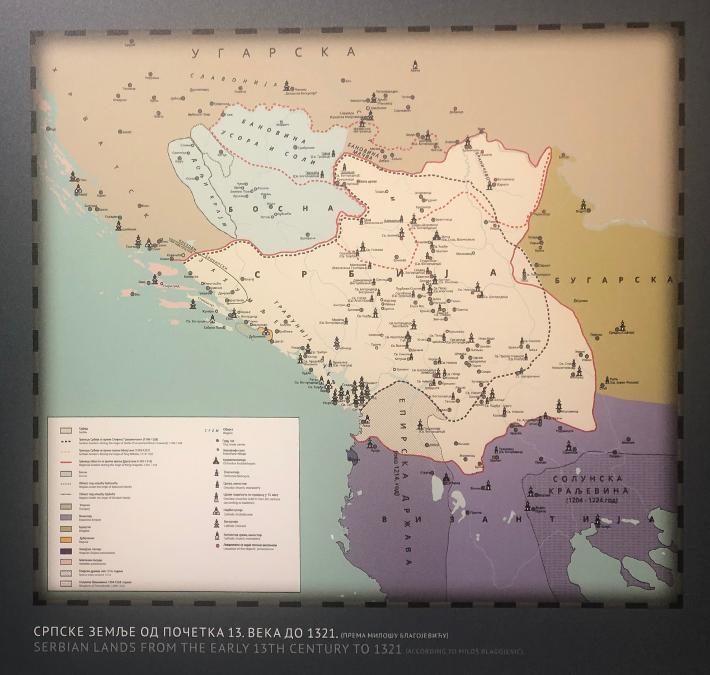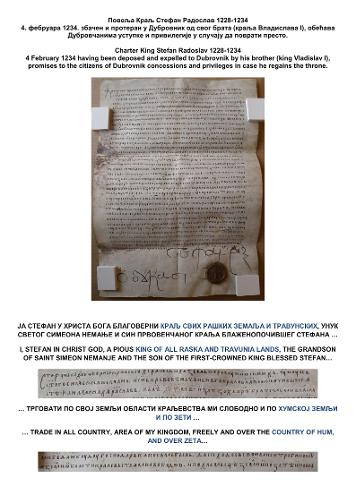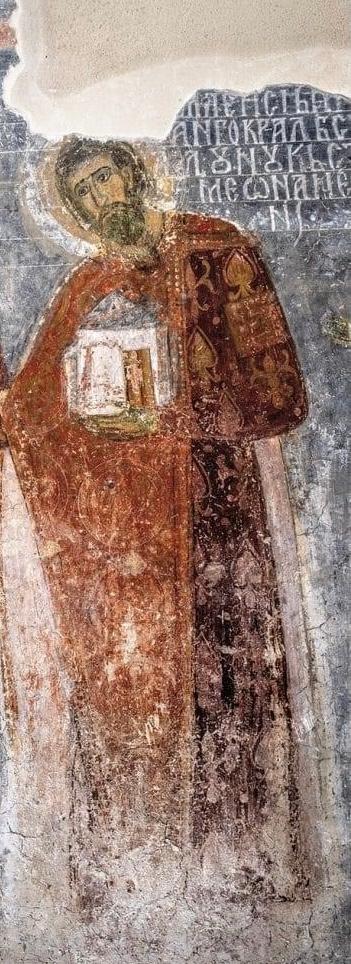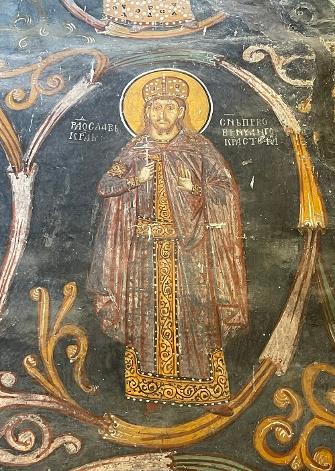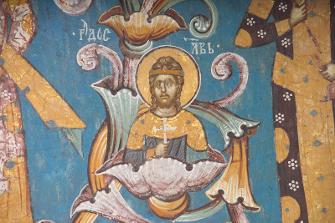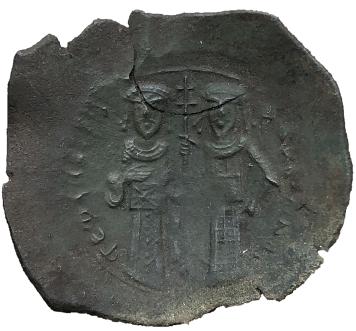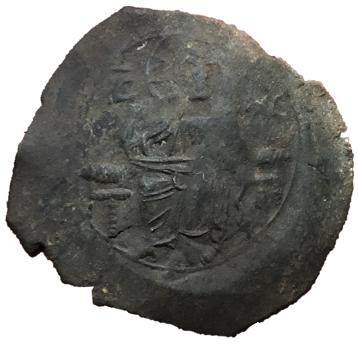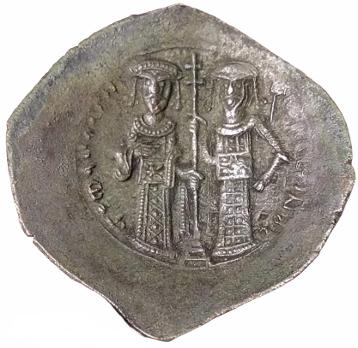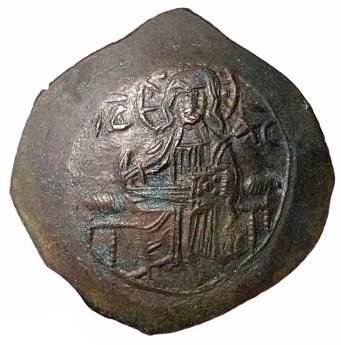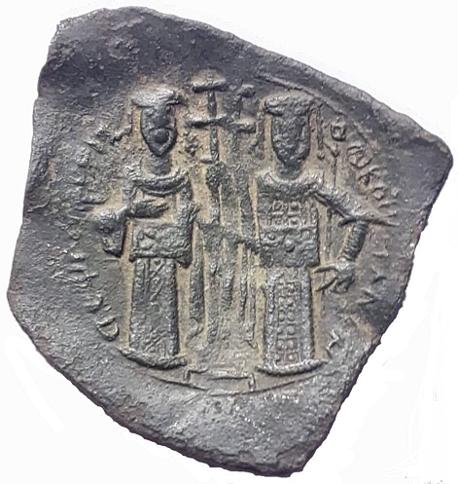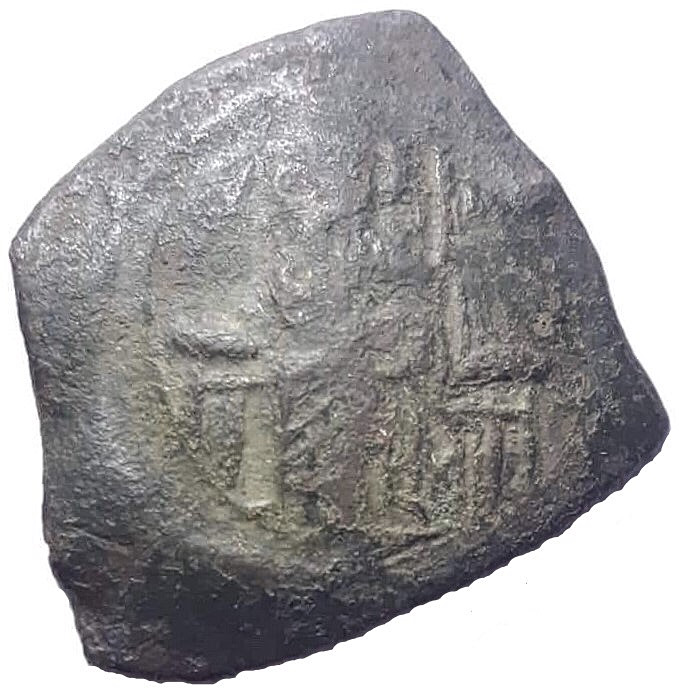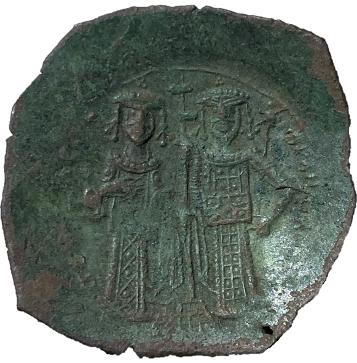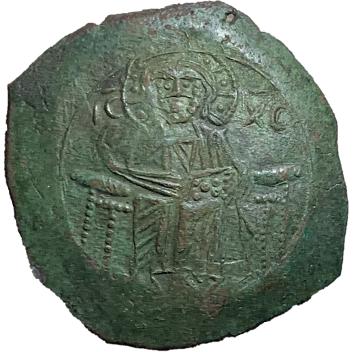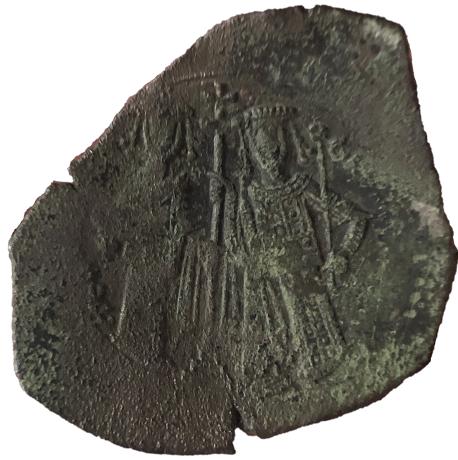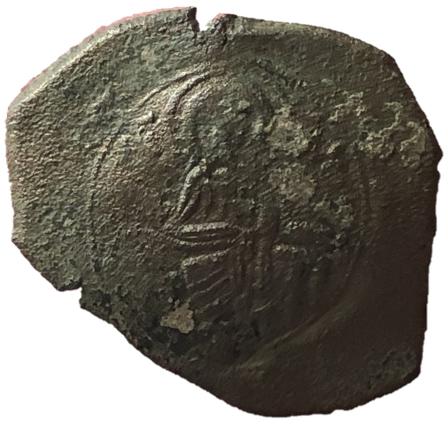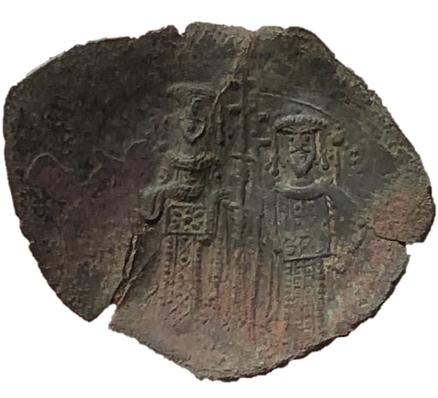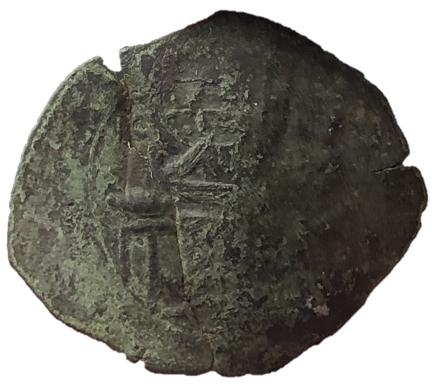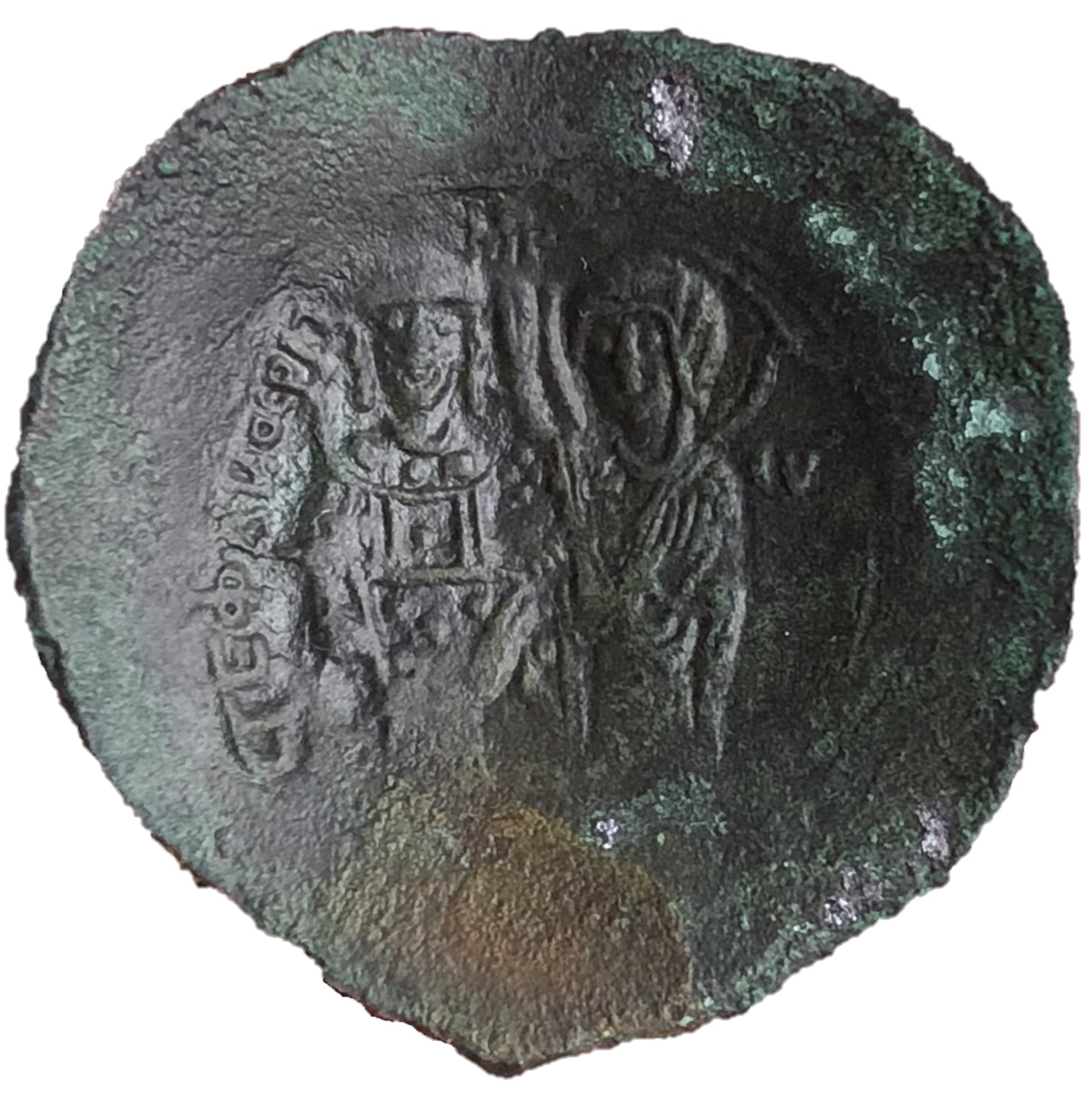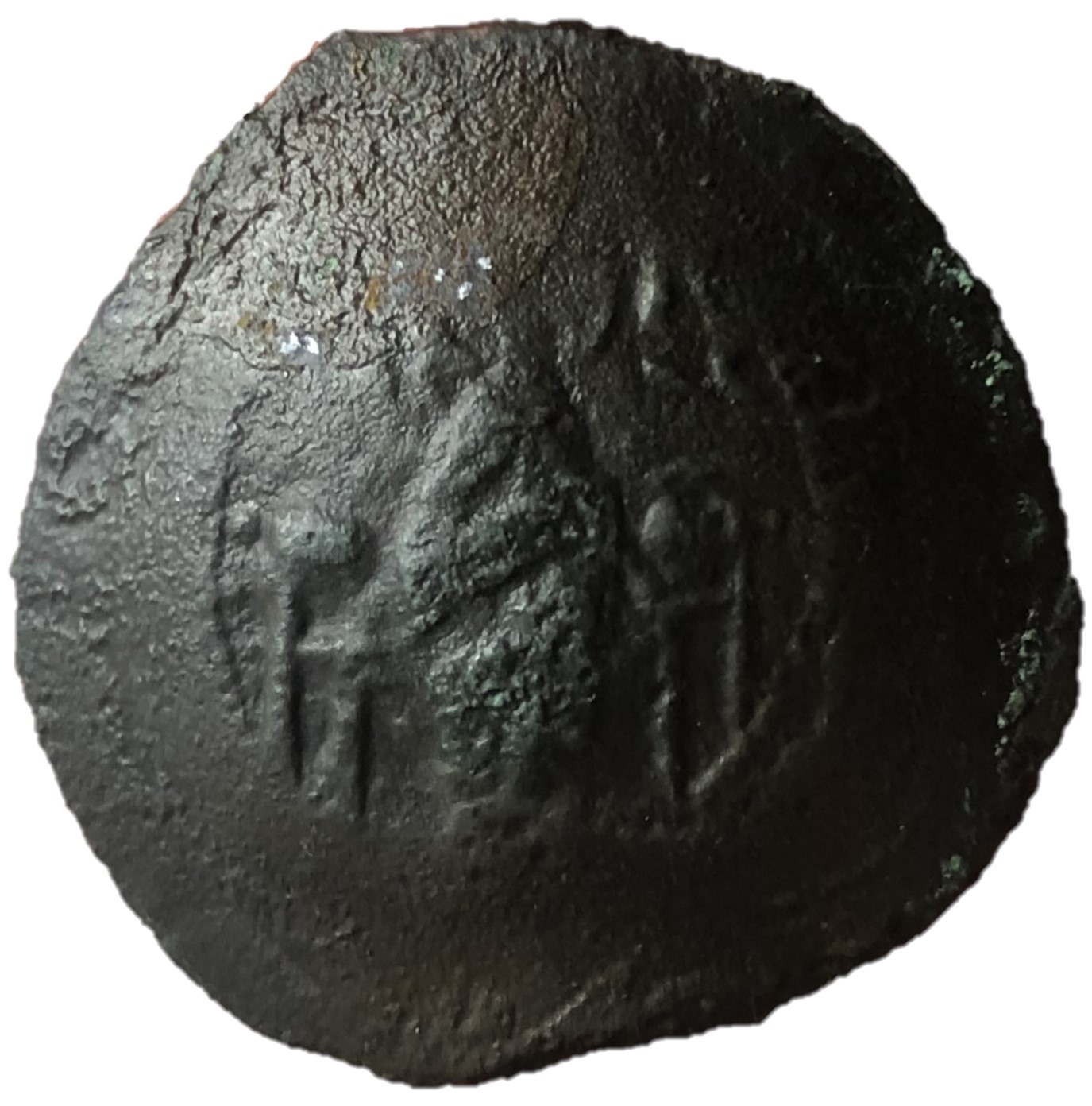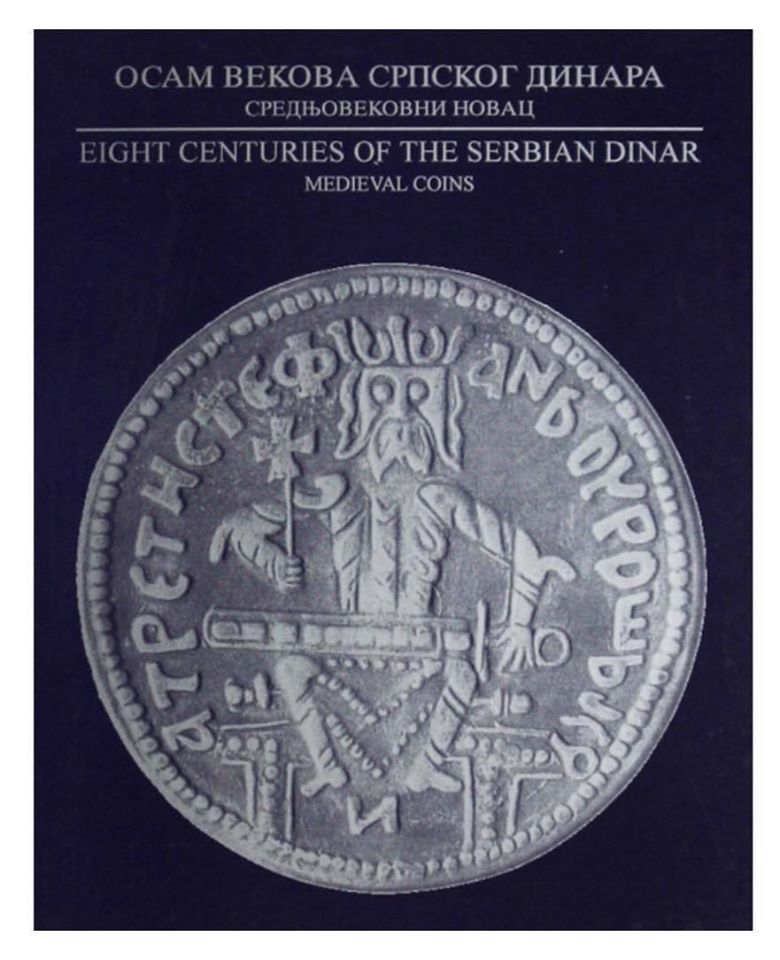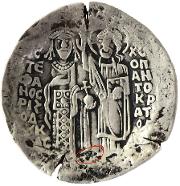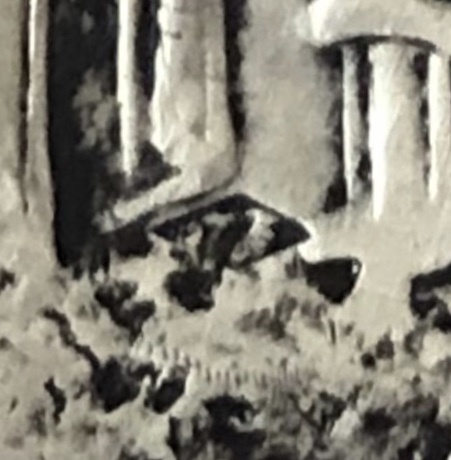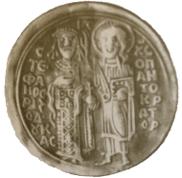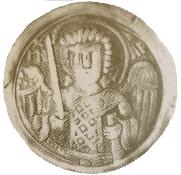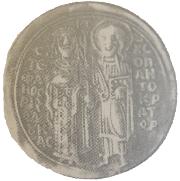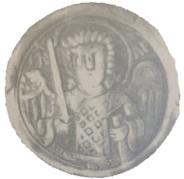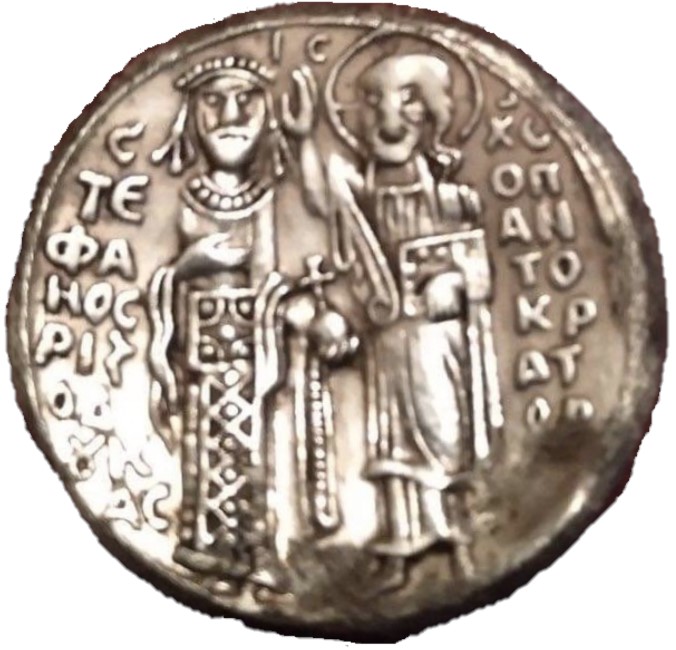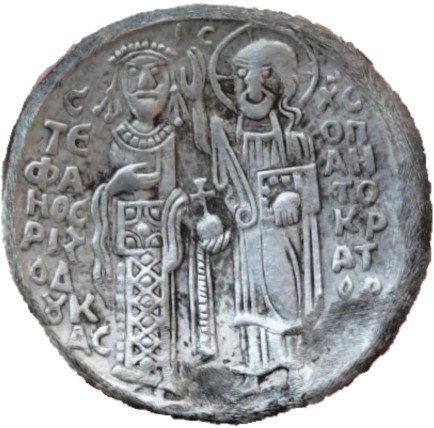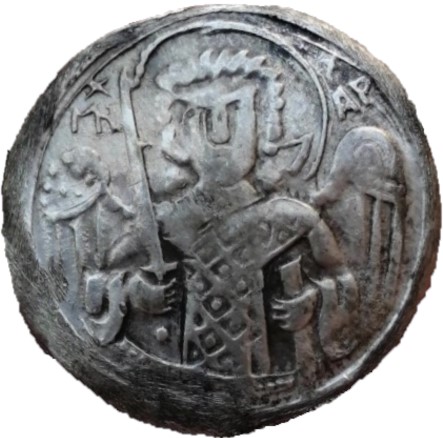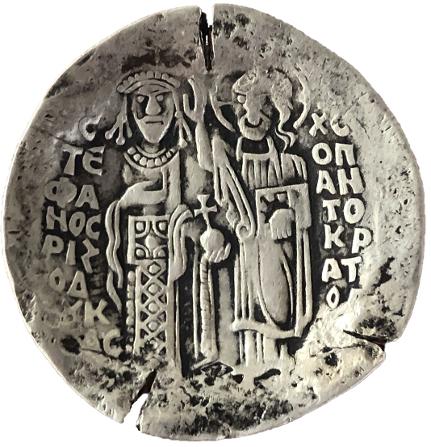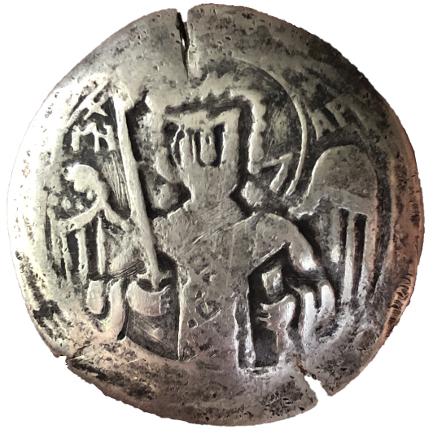Map of the Serbian state under King Stefan Radoslav (1228-1234), covering wide area from the river Neretva on the west to the river South Morava on the east and from the mountain Rudnik on the north to the Adriatic Sea on the south. Coastal area from the city of Skadar to Split.
"ЈА СТЕФАН У ХРИСТА БОГА БЛАГОВЕРНИ КРАЉ СВИХ РАШКИХ ЗЕМАЉА И ТРАВУНСКИХ, УНУК СВЕТОГ СИМЕОНА НЕМАЊЕ И СИН ПРВОВЕНЧАНОГ КРАЉА БЛАЖЕНОПОЧИВШЕГ СТЕФАНА …"
(I, STEFAN IN CHRIST GOD, A PIOUS KING OF ALL RASKA AND TRAVUNIA LANDS, THE GRANDSON OF SAINT SIMEON NEMANJE AND THE SON OF THE FIRST-CROWNED KING BLESSED STEFAN…)
Делимичан опис:
"... СИН ПРВОВЕНЧАНОГ КРАЉА УНУК СИМЕОНА НЕМАЊЕ."
Partial description:
" ... SON OF FIRST CROWNED KING GRANDSON OF SIMEON NEMANJA."
Detail of the fresco from the Serbian orthodox monastery Studenica, 1235,Republic of Serbia
РАДОСЛАВb CNbПРВО
KRAb ⛬ ВЂNYANГО
КРАСТЕФАНА :
РАДОСЛАВ КРАЉ СИН ПРВОВЕНЧАНОГ КРАЉА СТЕФАНА
RADOSLAV KING THE SON OF THE FIRST CROWNED KING STEFAN
Detail of the fresco "Nemanjic Family Tree" from the Serbian orthodox monastery The Patriarchate of Pec, Kosovo and Metohija, Republic of Serbia
• РАДОС ΛАВb •
РАДОСЛАВ
RADOSLAV
Detail of the fresco "Nemanjic Family Tree" from the Serbian orthodox monastery Visoki Decani, Kosovo and Metohija, Republic of Serbia
King Stefan Radoslav (1228-1234). Second Serbian king of the Nemanjic state.
Copper cup "double cross" type coin. 30mm, 3.792g.
Obverse: King in imperial attire facing, standing with St Constantine holding double cross banner together. St Constantine is holding his own smaller banner or scepter. Greek Legend: CTEФANOC PIZ (STEFAN KING) on the left and on the right side Greek letter Theta Θ and KONCTANTH (SAINT CONSTANTINE) referring to Constantine the Great, also known as Constantine I who was a Roman Emperor who ruled between 306 and 337 AD and born on the territory of today's Niš Serbia.
Reverse: Jesus Christ sitting on the high throne holding book of gospels decorated with 5 gems. Greek letters: IC XC (In Greek: Ιησούς Χριστός - Jesus Christ) above.
Reference: J ( 3 ), I ( 1.4 ), D (1).
Comment: Extremely rare coin in high grade. There are 93 coins of this type known to exist. Lovely toning, nice dark patina and natural aging. Fantastic detail with clear attire and visible legend. Letters appear a bit more spread around and smaller, kings and saints head looks slightly larger and double cross is smaller then all other known examples pointing to a different die being used and possibly by a different moneyer. Its the only combination of larger heads, smaller more spread legend and smaller double cross in existence. Small crack on the top but only thin surface damage.
Title PIZ is derived from Greek (ριζ), it literally means "root", rooted firmly, stable, established and it can also stand for high or elevated, in either case it is used as a royal title. In Greek language PIZ is also a number for 117. It is not certain and its just speculation at this point but according to Julian day calendar number 117 stands for April 27th or April 26th for a regular year. Greek word CTEФANOC, in Greek Στέφανος, is a masculine name derived from the Greek word στέφανος (stéfavos), meaning "wreath, crown" and by extension "reward, honor, renown, fame", from the verb στέφειν (stéfeiv), "to encircle, to wreathe".
Reference: #SR06
Not For Sale.
Estimated Value: 800 - 1200 -1500
Following signature and a seal is from a Serbian Royal Document at the State Archives in Dubrovnik from 4th February 1234, where King Stefan Radoslav, having been deposed and expelled to Dubrovnik by his brother (king Vladislav I), promises to the citizens of Dubrovnik concessions and privileges in case he regains the throne. Notice signature of the king: СТЕФАНОС РIZ just like it appears on his coins including letters CT joined together. Full document can be viewed at Medieval Artifacts page.
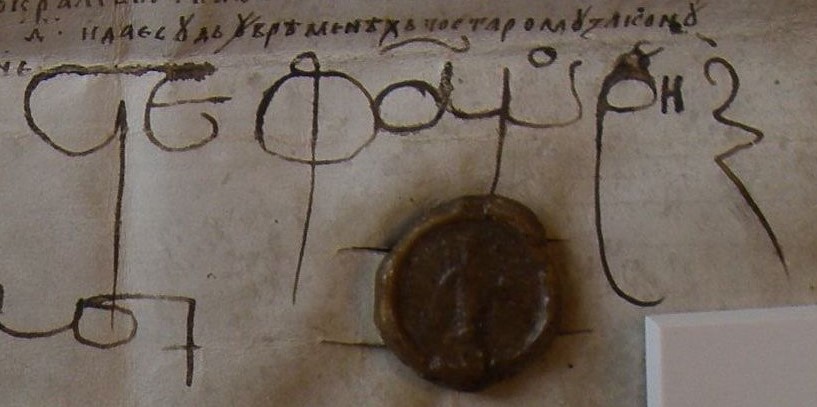
King Stefan Radoslav (1228-1234).
Copper cup "double cross" type coin. 29mm, 5.022g.
Obverse: King in imperial attire facing, standing with St Constantine holding double cross banner together. St Constantine is holding his own smaller banner or scepter. Greek Legend: CTEФANOC PIZ (STEFAN KING) on the left and on the right side Greek letter Theta Θ and KONCTANTH (SAINT CONSTANTINE) referring to Constantine the Great, also known as Constantine I who was a Roman Emperor who ruled between 306 and 337 AD and born on the territory of today's Niš Serbia.
Reverse: Jesus Christ sitting on the high throne holding book of gospels decorated with 5 gems in his left hand a blessing with his right hand. Greek letters: IC XC (In Greek: Ιησούς Χριστός - Jesus Christ) above. 4 dots inside halo, 2 on each side.
Reference: J ( 3 ), I ( 1.4 ), D (1).
Comment: Extremely rare coin in high grade. There are 93 coins of this type known to exist. Lovely toning, very nice patina and natural aging. Fantastic detail with clear attire and visible legend. This variant has smaller but very clear impression with a lot of excess material. Reverse seems bigger as there is less excess material visible. Jesus image is very visible and very well preserved which is often not the case in all known examples. Kings attire is very interesting, instead of dot in the middle of his belt as it is usually the case there is a star.
Reference: #SR08
Not For Sale.
Estimated Value: 800 - 1200 - 1500
King Stefan Radoslav (1228-1234)
Copper cup "double cross" type coin. 30mm, 2.610g.
Obverse: King in imperial attire facing, standing with St Constantine holding double cross banner together. St Constantine is holding his own smaller banner or scepter. Greek Legend: CTEФANOC PIZ (STEFAN KING) on the left and on the right side Greek letter Theta Θ and KONCTANTH (SAINT CONSTANTINE) referring to Constantine the Great, also known as Constantine I who was a Roman Emperor who ruled between 306 and 337 AD and born on the territory of today's Niš Serbia.
Reverse: Jesus Christ sitting on the high throne holding book of gospels decorated with 5 gems. Greek letters: IC XC (In Greek: Ιησούς Χριστός - Jesus Christ) above.
Reference: J ( 3 ), I ( 1.4 ), D (1).
Comment: Extremely rare coin. There are 93 coins of this type known to exist. Lovely toning, amazing dark yellow/black patina and natural aging. Excellent detail with very clear and visible legend. Double struck as two double crosses are visible. Base of the cross appears wider then usual but that is probably only due to coin being double struck. Obverse less preserved.
On the right side there is a very visible and clear Greek letter Theta Θ in front of KONCTANTH ("Constantine"). It looks like letter A inside letter O. That is word Agios (Greek: Άγιος; pl. Άγιοι, Agioi) masculine Greek word meaning "Sacred" or "Saint" (cf. Agios Dimitrios, Agioi Anargyroi). It is frequently shortened in colloquial language to Ai (cf. Ai Stratis). In this case it stands for saint Constantine.
Reference: #SR05 (SOLD)
King Stefan Radoslav (1228-1234)
Copper cup "double cross" type coin. 28mm, 3.494g.
Obverse: King in imperial attire facing, standing with St Constantine holding double cross banner together. St Constantine is holding his own smaller banner or scepter. Greek Legend: CTEФANOC PIZ (STEFAN KING) on the left and on the right side Greek letter Theta Θ and KONCTANTH (SAINT CONSTANTINE) referring to Constantine the Great, also known as Constantine I who was a Roman Emperor who ruled between 306 and 337 AD and born on the territory of today's Niš Serbia. Interesting 2 triple dotted marks above kings and saints head, possibly moneyer marks, so far only found on this example.
Reverse: Jesus Christ sitting on the high throne, blessing with his right hand and with his left hand holding book of gospels decorated with 5 gems. Greek letters: IC XC (In Greek: Ιησούς Χριστός - Jesus Christ) above. Halo has 3 dots on the left side and 3 dots on the right side.
Reference: J ( 3 ), I ( 1.4 ), D (1).
Comment: Extremely rare coin. There are 93 coins of this type known to exist. Lovely toning, amazing dark green/brown patina and natural aging. Excellent detail with parts of the legend missing. Base of the cross appears wide and big. Jesus on the obverse is very well preserved, one of the best known. His face and curly beard is very clear.
Reference: #SR07 (SOLD)
King Stefan Radoslav (1228-1234)
Copper cup "double cross" type coin. 32mm, 3.146g.
Obverse: King in imperial attire facing, standing with St Constantine holding double cross banner together. St Constantine is holding his own smaller banner or scepter. Greek Legend: CTEФANOC PIZ (STEFAN KING) on the left and on the right side Greek letter Theta Θ and KONCTANTH (SAINT CONSTANTINE) referring to Constantine the Great, also known as Constantine I who was a Roman Emperor who ruled between 306 and 337 AD and born on the territory of today's Niš Serbia.
Reverse: Jesus Christ sitting on the high throne holding book of gospels decorated with 5 gems. Smaller image of Jesus than usual. Greek letters: IC XC (In Greek: Ιησούς Χριστός - Jesus Christ) above.
Reference: J ( 3 ), I ( 1.4 ), D (1).
Comment: Extremely rare coin. There are 93 coins of this type known to exist. Lovely toning, patina and natural aging. Good detail with partially visible legend, letters are very close together. Double struck as two cross bases are visible. King and saint are tilted toward each other possibly only due to being double struck. Coin has been clipped on two sides probably for extra copper to be reused as it was practice in medieval times. These coins are so hard to get by and so very rare that having one in any condition its just amazing.
Reference: #SR03 (SOLD)
King Stefan Radoslav (1228-1234)
Copper cup "double cross" type coin. 32mm, 2.5g.
Obverse: King in imperial attire facing, standing with St Constantine holding double cross banner together. There is no visible legend. St Constantine is holding his own smaller banner or scepter. Greek Legend: CTEФANOC PIZ (STEFAN KING) on the left and on the right side Greek letter Theta Θ and KONCTANTH (SAINTCONSTANTINE) referring to Constantine the Great, also known as Constantine I who was a Roman Emperor who ruled between 306 and 337 AD and born on the territory of today's Niš Serbia.
Reverse: Jesus Christ sitting on the high throne holding book of gospels decorated with 5 gems. Greek letters: IC XC (In Greek: Ιησούς Χριστός - Jesus Christ) above.
Reference: J ( 3 ), I ( 1.4 ), D (1).
Comment: Extremely rare coin. There are 93 coins of this type known to exist. Lovely coloring, natural aging and red/green patina. Good detail but legend not very visible. Coin is not broken, its bent and has a crack on the top and on the bottom. Double struck as two crosses are visible.
Reference: #SR02. (SOLD)
King Stefan Radoslav (1228-1234)
Copper cup "Mary blessing the king" type coin. 25mm, 2.671g.
Obverse: King in imperial attire facing and holding globe, standing with Mary mother of Jesus being blessed by her. This is only known coin where king is holding a scepter, a ceremonial staff or a small banner on its own. Greek Legend: CTEФANOC PIZ (STEFAN KING), Greek initials between figures MP and ΘV on the right side standing for "Meter Theou" meaning "mother of god".
Reverse: Jesus Christ sitting on the high throne. This is the only known coin of this kind with high throne in the background. Greek letters: IC XC (In Greek: Ιησούς Χριστός - Jesus Christ) above.
Reference: Compare to J ( 2 ), I ( 1.3 ), D (2).
Comment: Extremely, extremely rare coin. So far one of its kind. There are only 8 known coins similar to this type, 7 have Jesus on the reverse without visible throne and on 1 there is also no visible throne on the reverse but king on the obverse has different attire. This is the only example with king holding a scepter and a globus on the obverse and Jesus is sitting on the high throne on the reverse. On all other known examples king is only holding globus there is no scepter. Lovely toning, dark brown/yellow/green patina and natural aging. Excellent detail with very visible legend. Very well preserved being nearly 800 years old.
There are claims that this is coin of Manuel I Comnenos 1118-1180 Byzantine Emperor or Theodore Komnenos Doukas ruler of Epirus and Thessaly from 1215 to 1230 and of Thessalonica and most of Macedonia and western Thrace from 1224 to 1230. (Same time that Radoslav was ruler of Serbia 1228-1233). He was also the power behind the rule of his sons John and Demetrios over Thessalonica from 1237–1246. He was also king Radoslav contemporary and a ruler that lived and ruled at the same time as he did.
Was Greek Legend: CTEФANOC PIZ added to a similar design in the 13th century or in the more modern times? It does appear that coin has been tempered with.
We dont know for sure but we do know that King Stefan Radoslav coin dies were produced in Thessalonica by the same moneyers that were making dies and coins of these mentioned rulers of Byzantine Empire and Thessalonica. King Radoslav was closely associated with and related to Byzantine emperors so its no surprise that his coins were made to look like Byzantine.
Below are some examples of Manuel I Comnenos, notice MANUHΛ on the left and ΔECПТ on the right:
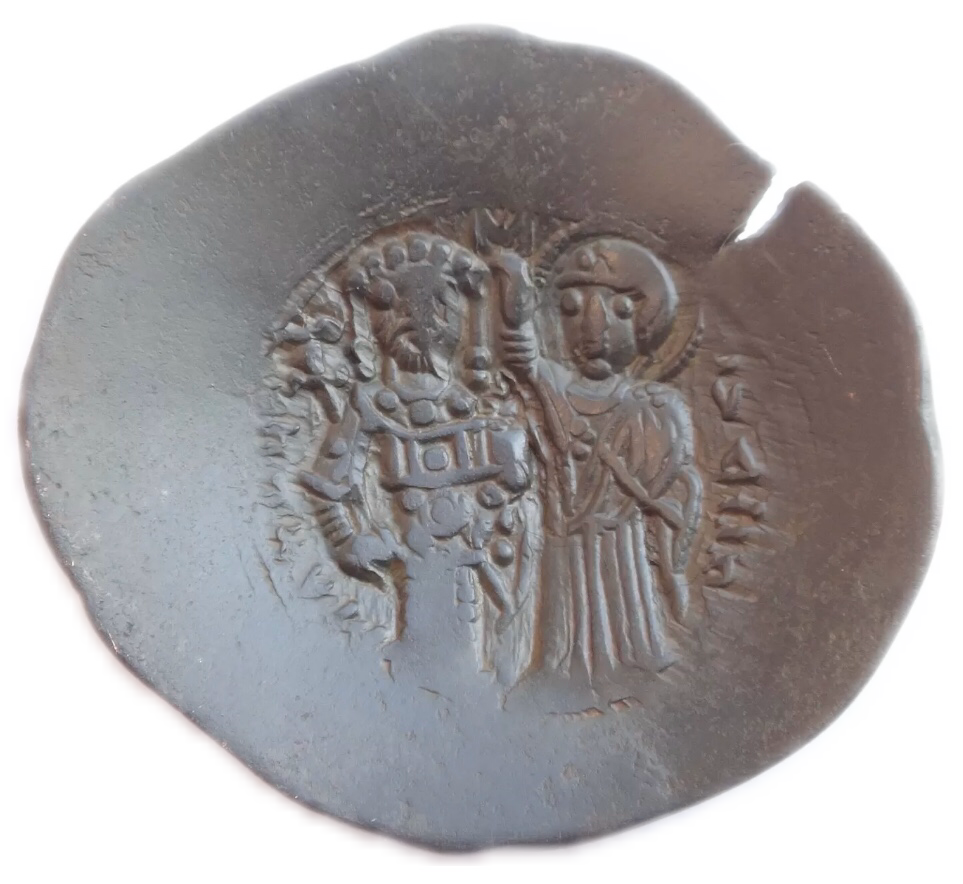
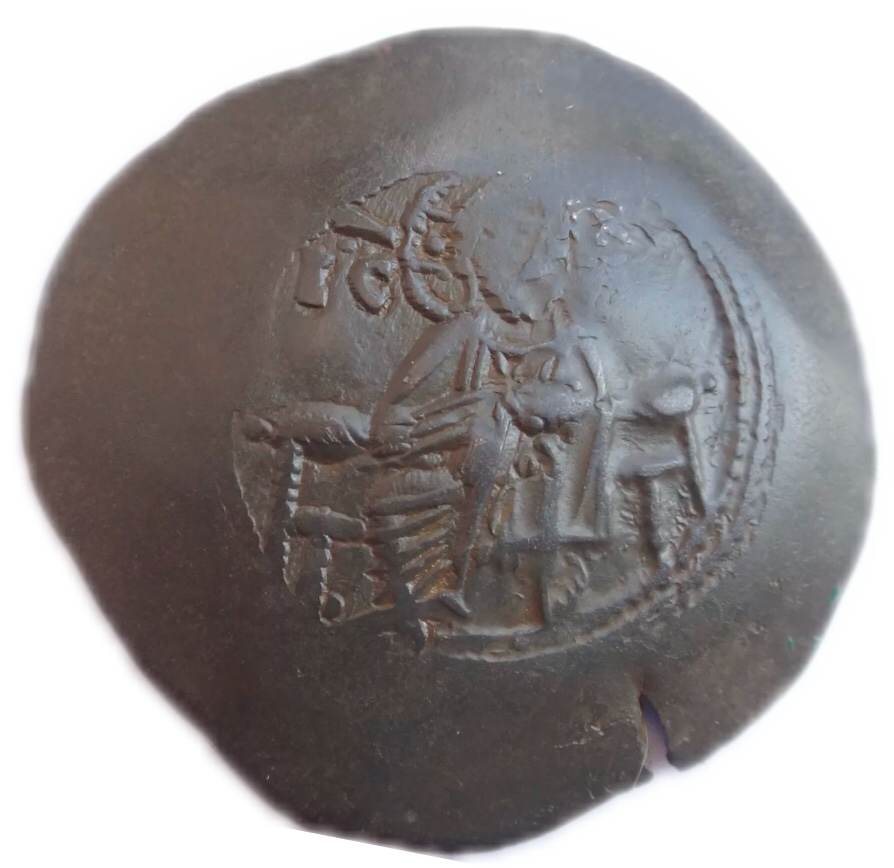
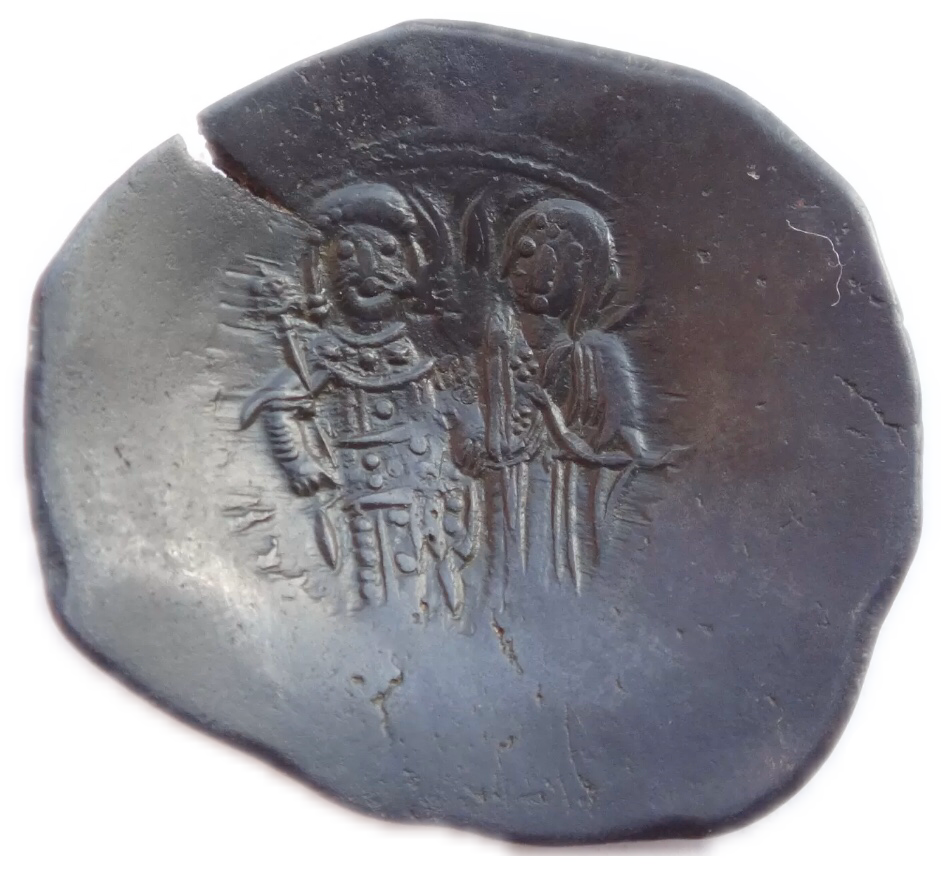
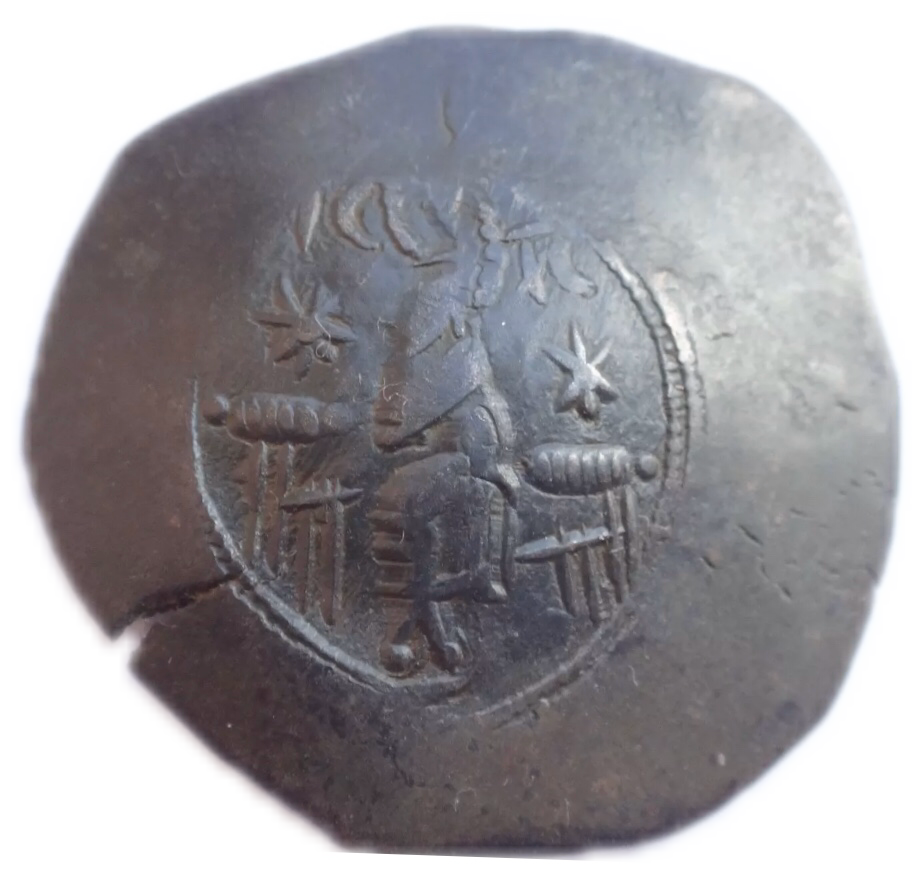

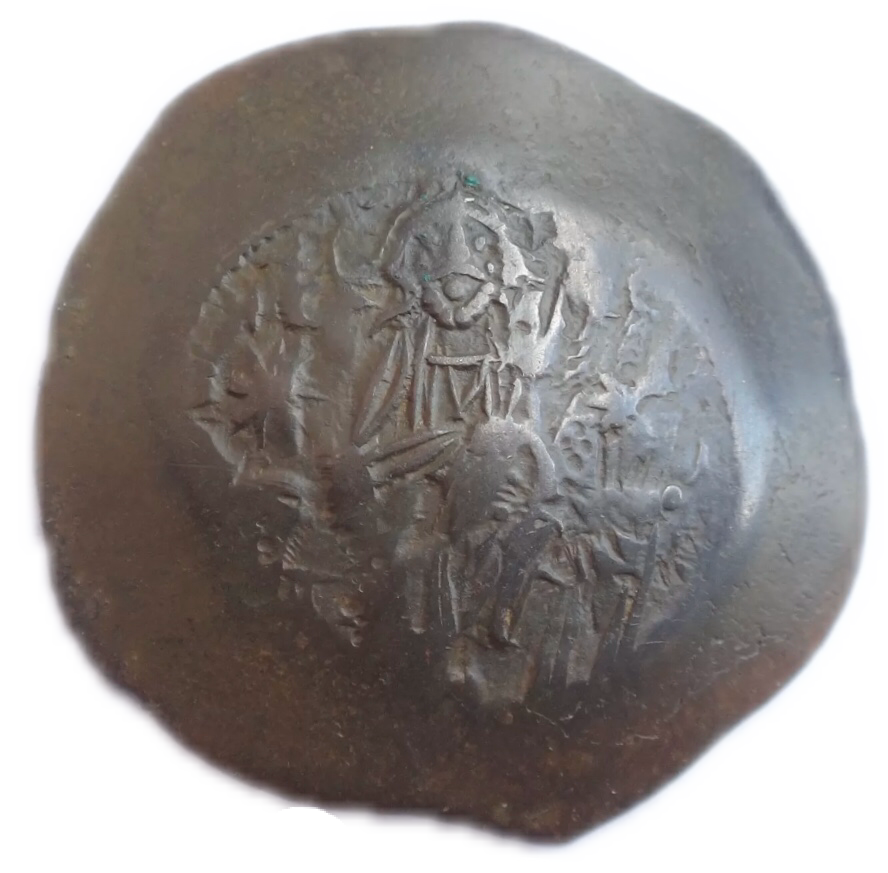
Compare images of the king and Mary on this Manuel I Comnenos also known as Manuel Porphyrogennetos example with the coin #SR04 below:

Reference: #SR04
Not For Sale.
Estimated Value: N/A
King Stefan Radoslav (1228-1234)
Silver cup "Jesus blessing the king" type coin. 25mm, 4.648g.
Obverse: King in imperial attire receiving blessing from Jesus or Jesus putting crown on his head holding globe in his left hand, Christ holding Gospel in his left hand.
2 sides Greek legend CTEФANOC PIZ (Greek letter Theta Θ ΔUKAC IC XC OПANTOKPATOP ("Stefan King From God Duka Jesus Christ Mighty").
Reverse: Winged Archangel Michael bust, nimbate, facing holding sword upright with his right and scabbard or sheath with his left. Greek legend: ΜΗ(ΧΑΗΛ) ΑΡ(ΧΑΓΕΛΟΣ) (Michael Archangel) to the sides.
Reference: Compare to Stockert NZ XVII 1914, p195, Um. Pregled I 1937, 16, Maric 1956 T XIII 1/2 and p75, J ( 1 ), I (1.1), D (3).
Comment: Extremely, extremely rare coin. Mints were located near many silver mines like Brskovo, Rudnik, Trepča, Srebrenica and Novo Brdo, Only 2 silver coins are known to exist and 1 is kept in Peoples Museum in Belgrade Serbia. Please check Home Page for comparison with other known King Radoslav silver and copper coins. Interestingly this coin is same weight 4.7g as a coin featured in NZ XVII 1914 p195 Par 5 by Dr Karl Stockert.
There are couple counterfeited one gold and one silver example almost identical to each other published in the book "Eight Centuries of the Serbian Dinar". They are similar but not the same, flat and not cup shape with minor differences making us conclude that they may have been made to look like ours below. See pictures below. No3 coin is another counterfeited example with subtle differences but we only have obverse image. Coin no4 has been seen on Limundo.com website on sale as a replica made of silver.
There are claims that our coin have been made by Zlatara Majdanpek Belgrade commissioned by Peoples Museum Belgrade redesigned by M. Jovanovic late 1980s or early 1990s, 30 years ago or so, in limited quantity using silver and counter-marked ZM and/or 925. Admittedly there is a mark that may look like a counter-mark. This mark is not visible on 4 other examples mentioned here. Please see pictures below.
Further research and proof is needed.
Obverse difference: Notice on all 3 saint legs are not straight but tilted to the right. On the no1 and no2, globus that king is holding is straight not tilted to the left like our example. On all 3 coins kings chin is less pointy and more round. Letters like C and P are not matching, they are either smaller or bigger. On the no3 kings hand that is holding globus has shorter fingers. Saints fingers holding the book of Gospels are shorter on all 3. Main difference of course is that all these 3 are flat not cup shape. Interestingly no3 has a shadow just under letter O and over letter P just like our #SR01 example.
Reverse difference: Head of the Archangel on the coin no1 and no2 is bigger, bigger chin and visible mouth. Area around nose and eyes is smaller. Area between right wing and a halo is smaller. Scroll Archangel is holding is straight not tilted like ours and sword is thicker. Hair pieces are bigger and longer.
Reference: #SR01
Not For Sale.
Estimated Value: N/A
Copyright © 2020
